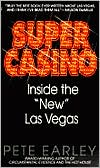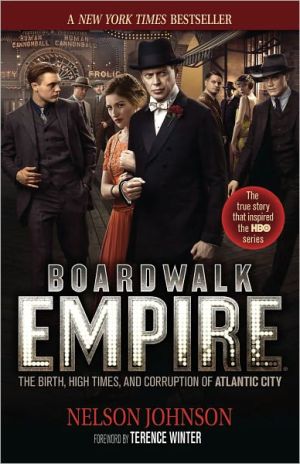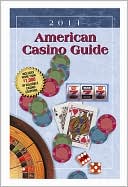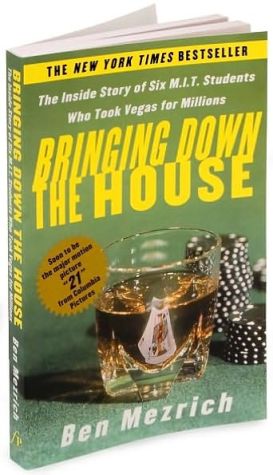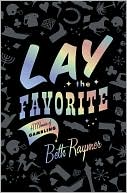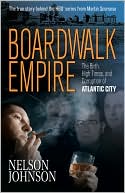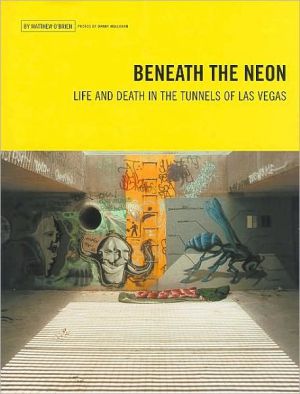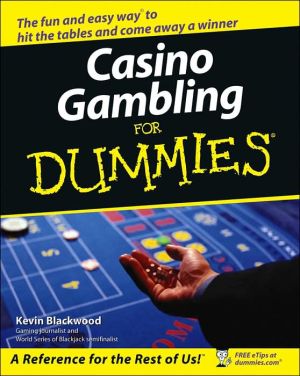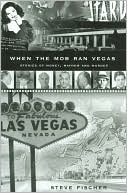Super Casino: Inside the New Las Vegas
In this lively and probing book, award-winning author Pete Earley traces the extraordinary evolution of Las Vegas -- from the gaudy Mecca of the Rat Pack era to one of the country's top family vacation spots. He revisits the city's checkered history of moguls, mobsters, and entertainers, reveals the real stories of well-known power brokers like Steve Wynn and legends like Howard Hughes and Bugsy Siegel, and offers a fascinating portrait of the life, death, and fantastic rebirth of the Las...
Search in google:
Takes a look at the life, death, and rebirth of the Las Vegas Strip, especially the new super casinos, how they run, and who runs them. Traces the checkered history of Las Vegas, and reveals the real stories of well-known power brokers like Steve Wynn, Vegas legends like Howard Hughes, and the rise and fall and rise again of the entrepreneurs behind Circus Circus, one of the largest gaming corporations in the nation. Includes b&w photos. Early is a former reporter for , and author of several books. Annotation c. Book News, Inc., Portland, OR Publishers Weekly For a portrait of razzle-dazzle Las Vegas, this is a curiously sober book. Earley, an Edgar and Robert F. Kennedy Award winner (Circumstantial Evidence), gained the cooperation of Circus Circus Enterprises, owners of the new pyramid-shaped Luxor super casino, to write an awkward hybrid of a work: part business history, part vignettes of life in Las Vegas. The first segment, more than one third of the book, tells the history of Circus Circus. It's a solid account of the rise of corporate casinos by Earley, a former Wall Street Journal reporter, but as Vegas tales go, there's nothing hugely dramatic in the Circus Circus story. The book's sprightlier but diffuse second part describes episodes inside the Luxor and the individual characters who populate it: a casino boss, a showgirl, a security guard, etc. Earley showcases some unflattering scenes, such as a security guard's beating of a homeless man, and picks up some only-in-Vegas anecdotes, like the many ways casino dealers have tried to hide stolen chips (e.g., in a brassiere). But only one of these characters is compelling: a young prostitute who opens up to the author to a remarkable degree; surviving the Las Vegas jungle, she trains as a blackjack dealer and ultimately leaves town. Earley does not comment directly on the broader moral issues of gambling: halfway through the book, he quotes a cabbie who says the city is based on greed, but near the end, he cites a Luxor manager who asserts that it's a place "where people come to forget their problems." Andres Martinez's 24/7 (Forecasts, Oct. 25) goes further in conveying the manic energy of Las Vegas, but the city still awaits a stylish chronicler who can fully capture its uniqueness. (Jan.) Copyright 1999 Cahners Business Information.
Las Vegas Bound!\ \ Within minutes after the Delta flight lifts off from the Salt Lake City airport runway, the passenger in seat 22B lowers the plastic tray in front of him and opens a deck of cards.\ "Blackjack?" he asks the woman next to him. "Just for fun. Might as well get started early!" She lowers her tray as he begins to deal.\ "It's our first time," a honeymooner two rows back confides to the airline attendant taking drink orders. "My husband wants to play poker, but me, I'm going right for the slots. Do you know of any good places to eat?"\ "The all-you-can-eat buffet at the Rio is the best!" the man sitting across the aisle volunteers.\ "You really need to see the white tigers at the Mirage!" offers another.\ "Don't play any of the slots at the airport," a nearby passenger warns. "They're the tightest in town!"\ The flight attendant, whose badge identifies her as Jasmine, explains that passengers en route to Las Vegas are usually a talkative bunch. "It's like when we have a Super Bowl flight and everyone shows up with their faces painted, hooting and hollering. We've had people trying to shoot craps down the aisles on these flights. At least when we are flying into Las Vegas, everyone is happy."\ "I see it!" a boy announces less than an hour later. In the distance, Las Vegas appears in miniature, as if its Strip hotels are pieces on a Monopoly game board. It is a city that sprouts unexpectedly in a dead valley, encircled by gray mountains with slag surfaces of stone and gravel. After a flight over cracked riverbeds, wind-burned gulches, and the scorching, moonlike surface of the Mojave Desert, Las Vegas is splashes of color. From the air, green golf fairways come into focus, along with the intense blue shapes of resort and backyard swimming pools. As the plane descends there's more: black asphalt parking lots, gray concrete driveways, brown-necked palm trees, the red tile roofs of Spanish-style houses ringed by privacy walls made of pink adobe.\ "Look, look! There they are!" a woman cries as the flight circles McCarran International Airport, at the southern edge of the city. All aboard have a clear view of the world-famous Strip as the woman begins identifying the casinos by name, as if they were friends. "There's Caesars Palace and the Mirage! Can you see the volcano? Oh, look -- there's the Luxor and MGM and New York New York!"\ Forty-seven percent of the tourists who visit Las Vegas each year arrive by air, making McCarran the tenth busiest airport in the nation. Every day, eighty-four thousand passengers arrive or depart. That's the equivalent of nearly one-tenth of the entire Las Vegas population moving through McCarran in a single day. On most afternoons, air traffic controllers can't keep up. They keep planes circling while waiting for runways to clear.\ If a traveler was completely ignorant of Las Vegas's history and somehow missed seeing the outlandishly shaped super casinos on its Strip, he might be fooled into thinking as his flight circled the airport that he was about to land in a typical southwestern city. A handful of tall office buildings rise from the downtown area and, much like the rings on a tree stump, the urban sprawl rippling outward reflects how the city has grown and prospered. The farther from the city center, the bigger and newer the houses, until you reach the fringes where shopping malls sit next to planned communities with golf courses, tennis and swim clubs, and cul-de-sacs lined with homes. It could be Phoenix, Albuquerque, or El Paso.\ But once a traveler enters the McCarran terminal, any notion that Las Vegas might be ordinary is quickly dispelled. The voice from the ceiling speakers telling travelers to stand to the right of the moving walkway is not some computer-generated drone. It's Joan Rivers. At the baggage claim area, banks of slot machines are tucked between the carousels.\ Bells ring, coins tumble into chrome trays, but it is the continuous rhythm made by these slot machines' electronic spinning wheels that permeates the air. Duh-duh-em-da-a-lop! Duh-duh-em-da-a-lop! A hundred times each minute. A million times each hour. Duh-duh-em-da-a-lop! Duh-duh-em-da-a-lop! It is impossible to escape. Duh-duh-em-da-a-lop! Duh-duh-em-da-a-lop! In supermarkets, where slot machines are stationed near the cashiers so shoppers can rid themselves of change; in restaurants, where they are set up outside the rest rooms; in neighborhood pubs, where their twirling wheels are built into glass-topped tables; and in convenience stores, where they can be found near the soda machines, the games emit the same strain: Duh-duh-em-da-a-lop! Only one noise can challenge it, and that's the metallic snapping that issues from video poker machines dealing their picture-tube cards. Snap, snap, snap, snap, snap! Duh-duh-em-da-a-lop! Snap, snap, snap, snap, snap! Duh-duh-em-da-a-lop! Cruise the Strip with your car windows open and the radio switched off early any morning and the ringing of spinning wheels and snapping of electronic cards is all around you. It is the city's unofficial theme song.\ The eyes are assaulted as intensely as the ears. During the short ride from McCarran Airport into the city, visitors are greeted by a second phenomenon: the Las Vegas glow. Electronic billboards define the city's skyline. The rainbow-colored neon tubing burns day and night. The lightbulb-re-created face of singer Tom Jones emanating from the fifty-foot electronic billboard outside the entrance of the MGM Grand catches the eye. A forty-billion-candlepower spotlight shoots a continuous beam of light ten miles into the desert blackness from dusk to dawn from the apex of the Luxor pyramid. Fifteen-foot-tall knights joust electronically outside the medieval Excalibur hotel and casino; showgirls kick high with strobe-light legs on the Stratosphere's sign. It is not just the colors of the fifteen thousand miles of lights that overwhelm onlookers. Throbbing, flickering, streaking, sparkling, twinkling, at night the entire city seems one enormous, pulsating neon billboard.\ Has there ever been another destination like Las Vegas? There is nowhere gaudier, splashier, more electric. Call it what you will: Lost Wages, Pair-o-Dice, Never-Never Land. In a location that normally attracts only lizards and rattlesnakes, this is a nonstop temple to excess, where fantasies become true.\ For most tourists, Las Vegas consists of two districts: the legendary Strip and Glitter Gulch, an avenue of casinos located in the center of the city. The downtown joints used to be much grittier than their upscale Strip rivals, largely because of their seedy location. Las Vegas was founded by the railroad. Consequently, there is an Amtrak station in the center of the city, next to railroad tracks that run north and south, cutting the town in half. The front doors of the station open onto Fremont Street, the city's de facto main street, which runs east to west and is where most of the early casinos took root. In the late 1940s, the four-block stretch between the train station and Fourth Street was nicknamed Glitter Gulch because there were so many neon signs outside its casinos that it looked to arriving train passengers as if they were disembarking into a gaudy ravine. One of the most memorable signs featured Vegas Vic, a skinny neon cowboy with a red-tipped cigarette dangling from his lips and a bent elbow and outstretched thumb that pointed toward the Pioneer Club. But the Gulch's glitter began to dim during the 1950s, when the Strip became the city's hottest gambling spot. Few downtown casinos could compete with its fancy resorts. Most lacked frills and class. They were dark, dirty, and dingy. By the 1960s, downtown was where the derelicts hung out begging for quarters that they hoped to turn through chance into enough for a bottle of whiskey. Even the casinos' names seemed shopworn: Horseshoe, Four Queens, Lady Luck, Golden Nugget. But during the booming 1980s and 1990s, Glitter Gulch got a face-lift. Nearly every club was remodeled. The bums were banished. The city helped out in 1995 by closing a portion of Fremont Street to traffic and turning it into a pedestrian mall covered with a four-block-long metal awning. Now Glitter Gulch is illuminated at night by 2.2 million bulbs hidden in the mall's awning. They flash in computer-choreographed patterns with such brilliance it is impossible to tell it is nighttime.\ The Strip begins three miles south of Glitter Gulch on Las Vegas Boulevard, which once was the main north-south route for motorists coming into town. In the 1940s, this was where the city limits ended, and although the city has expanded its boundaries southward, the Strip still starts where Las Vegas Boulevard intersects with Sahara Avenue, so called because the Sahara hotel and casino sits at the intersection's southeast corner.\ Motorists riding those three miles south from Glitter Gulch toward the Strip get to see a Las Vegas never shown in glitzy ads. They pass through one of the city's scroungier neighborhoods. Flat-roofed World War II -- era houses sit in disrepair along Las Vegas Boulevard, iron bars protecting their windows. Pawnshops, wedding chapels, one-hour-photo booths, liquor stores, 1950s-era motels featuring X-rated movies, adult bookstores, topless bars, and used furniture stores line the boulevard. But all these dives disappear at the Sahara Avenue intersection. From this point on, motorists are shaded by towering palm trees that rise from the landscaped median that divides the boulevard as it expands from four to six lanes along the next four miles. The Strip's oldest resorts are located close to Sahara Avenue, on what is known as the "northern tip" of the Strip. Most of them have familiar names: Circus Circus, Stardust, Frontier, Desert Inn, Riviera. Although some of their exteriors have been remodeled, they look much as they did when they were first erected in the 1950s and 1960s. The popularity of the northern tip has been dropping over the years as tourists moved farther south to newer and more elaborate casinos. In 1995, a renegade casino owner named Bob Stupak tried to reverse this southern trend by erecting a super casino on the northern tip. Located a short distance north of Sahara Avenue, Stupak's Stratosphere Tower rises 119 stories high, making it the tallest building in the West. Stupak put a roller coaster on its roof and added a ride that rockets thrill seekers along a metal antenna at the tower's peak even higher into the sky. But despite its daring rides, the Stratosphere has failed to draw crowds, largely because tourists feel uncomfortable walking through the seedy neighborhood at its base.
Counting Cards1Part 1In the Beginning15Prologue17Part 2The Luxor167Winter: Reincarnation169Spring: A Spin of the Wheel231Summer: Betting It All283Fall: Crapped Out325Epilogue373Acknowledgments376Index379
\ Publishers Weekly - Publisher's Weekly\ For a portrait of razzle-dazzle Las Vegas, this is a curiously sober book. Earley, an Edgar and Robert F. Kennedy Award winner (Circumstantial Evidence), gained the cooperation of Circus Circus Enterprises, owners of the new pyramid-shaped Luxor super casino, to write an awkward hybrid of a work: part business history, part vignettes of life in Las Vegas. The first segment, more than one third of the book, tells the history of Circus Circus. It's a solid account of the rise of corporate casinos by Earley, a former Wall Street Journal reporter, but as Vegas tales go, there's nothing hugely dramatic in the Circus Circus story. The book's sprightlier but diffuse second part describes episodes inside the Luxor and the individual characters who populate it: a casino boss, a showgirl, a security guard, etc. Earley showcases some unflattering scenes, such as a security guard's beating of a homeless man, and picks up some only-in-Vegas anecdotes, like the many ways casino dealers have tried to hide stolen chips (e.g., in a brassiere). But only one of these characters is compelling: a young prostitute who opens up to the author to a remarkable degree; surviving the Las Vegas jungle, she trains as a blackjack dealer and ultimately leaves town. Earley does not comment directly on the broader moral issues of gambling: halfway through the book, he quotes a cabbie who says the city is based on greed, but near the end, he cites a Luxor manager who asserts that it's a place "where people come to forget their problems." Andres Martinez's 24/7 (Forecasts, Oct. 25) goes further in conveying the manic energy of Las Vegas, but the city still awaits a stylish chronicler who can fully capture its uniqueness. (Jan.) Copyright 1999 Cahners Business Information.\ \ \ \ \ Library JournalEarley, who previously took readers inside a major prison (The Hot House: Life Inside Leavenworth) and a spy ring (Family of Spies: Inside the John Walker Spy Ring), now takes us inside Las Vegas in this well-written, behind-the-scenes look at the machinations of the corporate world of gambling. In an unprecedented move, executives from Circus Circus Enterprises gave Earley (a former Washington Post reporter) carte blanche to attend any and all meetings, to interview staff without fear of reprisal, and to observe life inside the Luxor and Circus Circus casinos. He introduces readers not only to Vegas executives but to dealers, floor managers, and security personnel. We follow a teenage hooker from her arrival in Las Vegas to her exit two years later; we meet a dancer following her dreams; we witness the firing of an employee. By the end, you'll wonder if anyone has a chance to come out ahead against the corporate mafia who have renewed Las Vegas with the Super Casinos that line the Strip. An excellent read, this book is fast-paced, interesting, and credible. Recommended for public libraries of all sizes and for academic libraries, too.--Sandra Isaacson, Las Vegas Copyright 1999 Cahners Business Information.\ \
